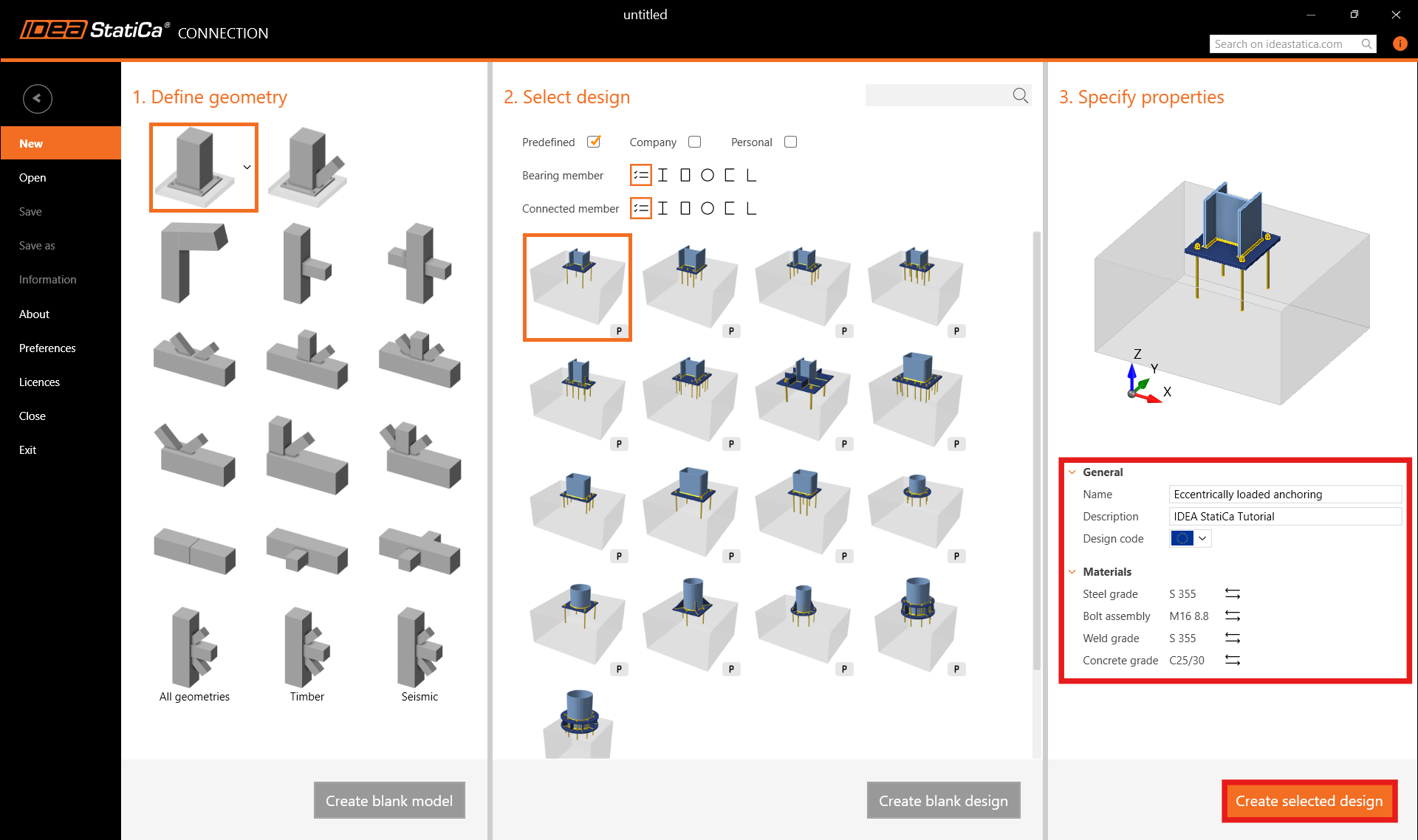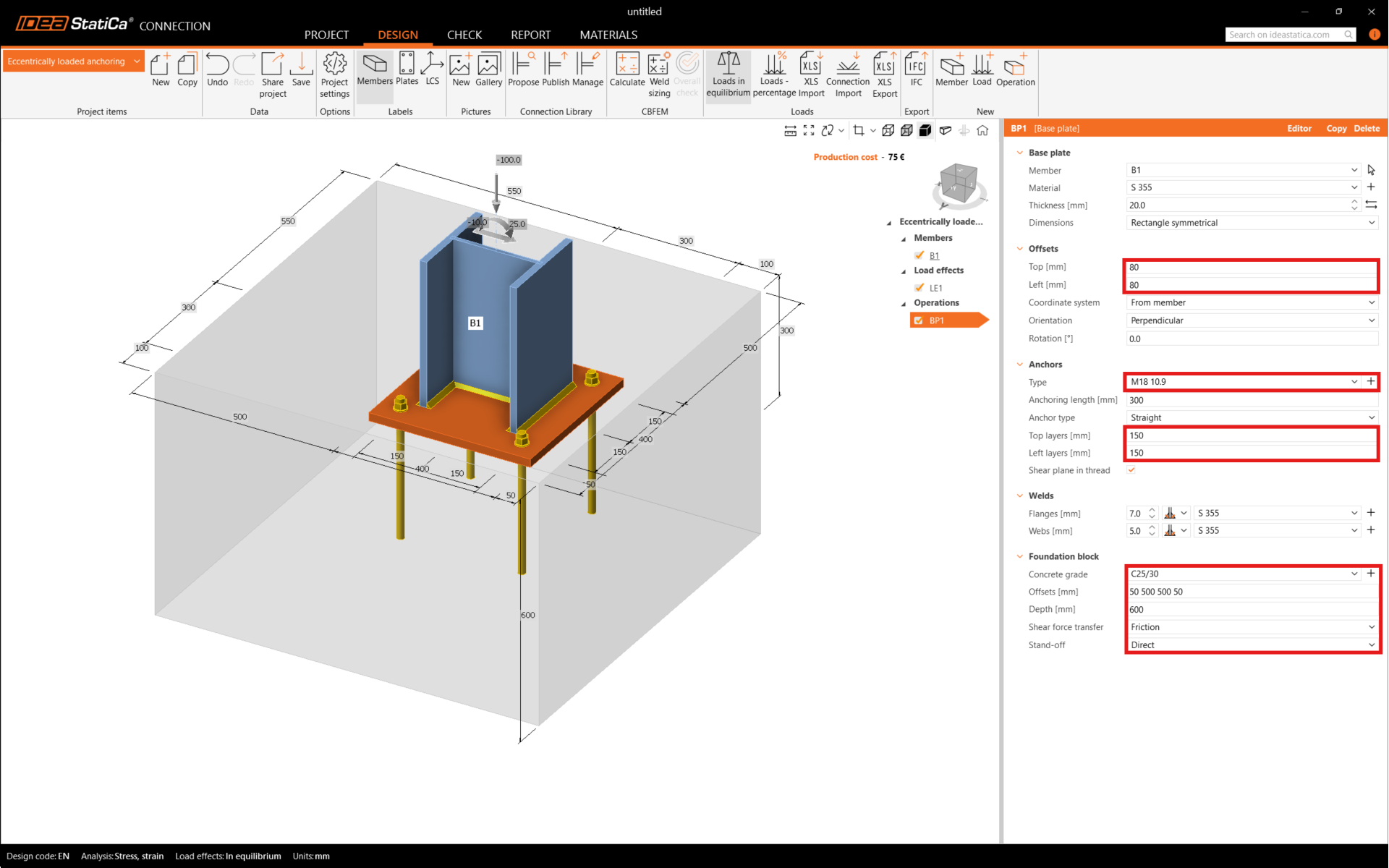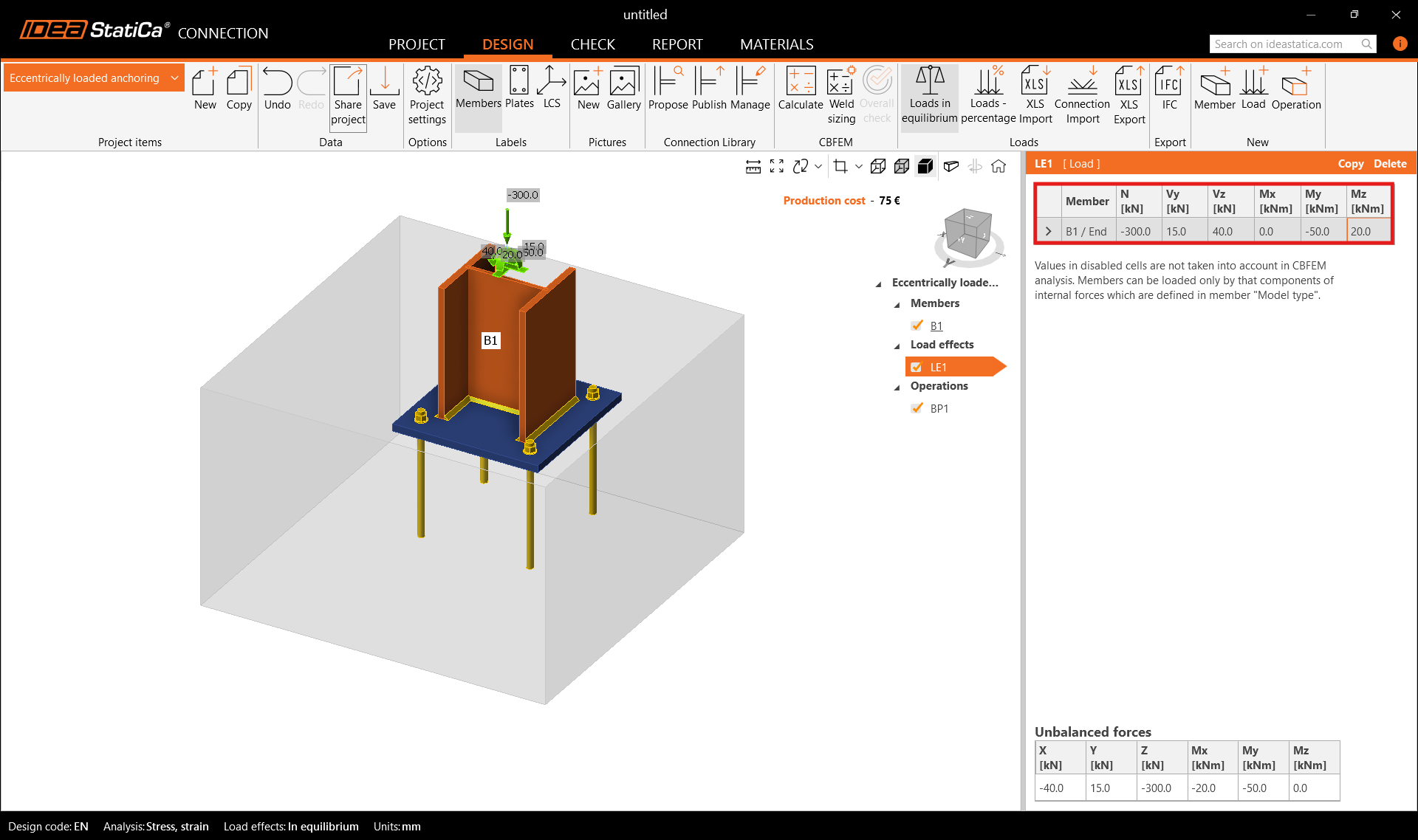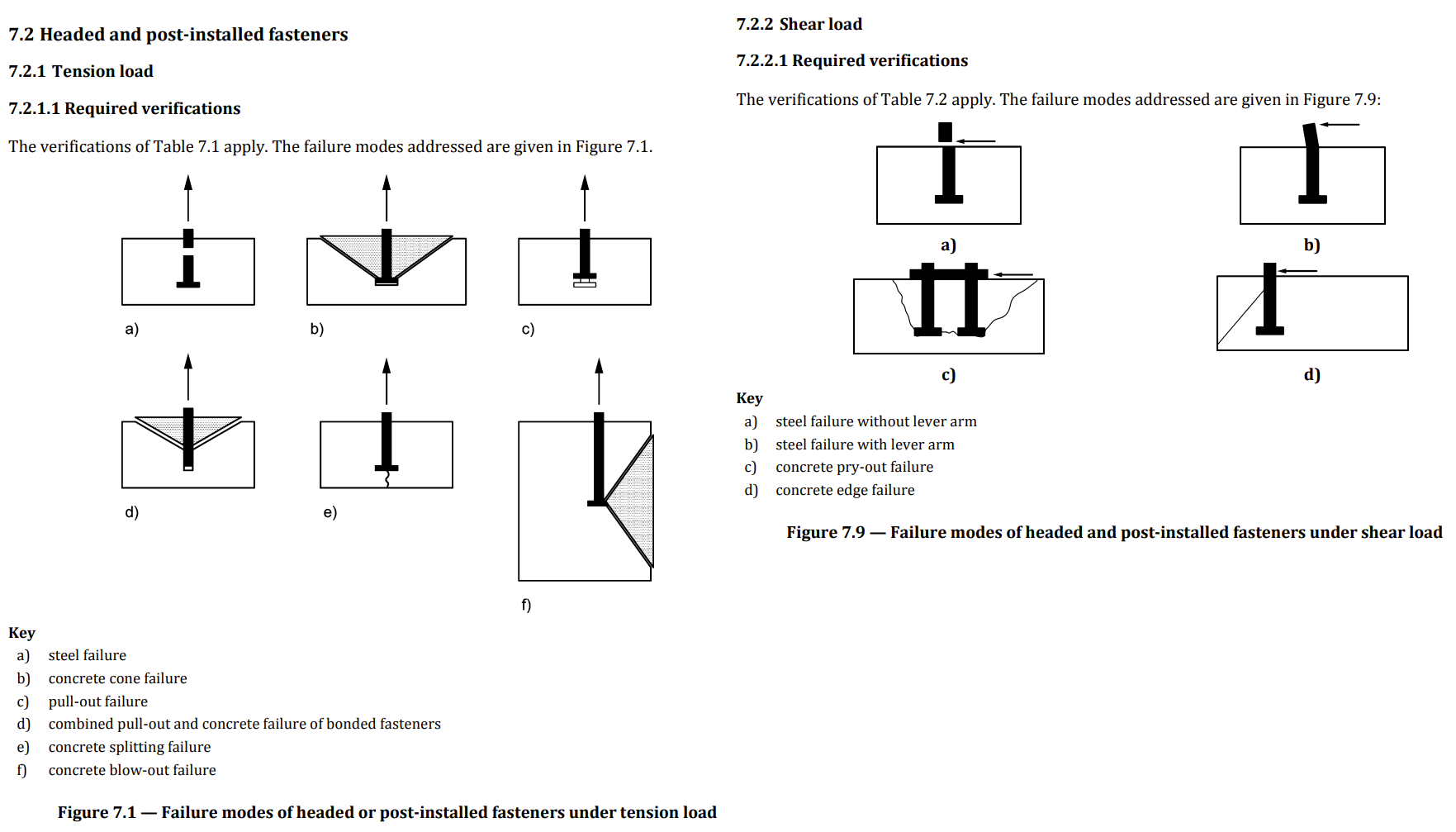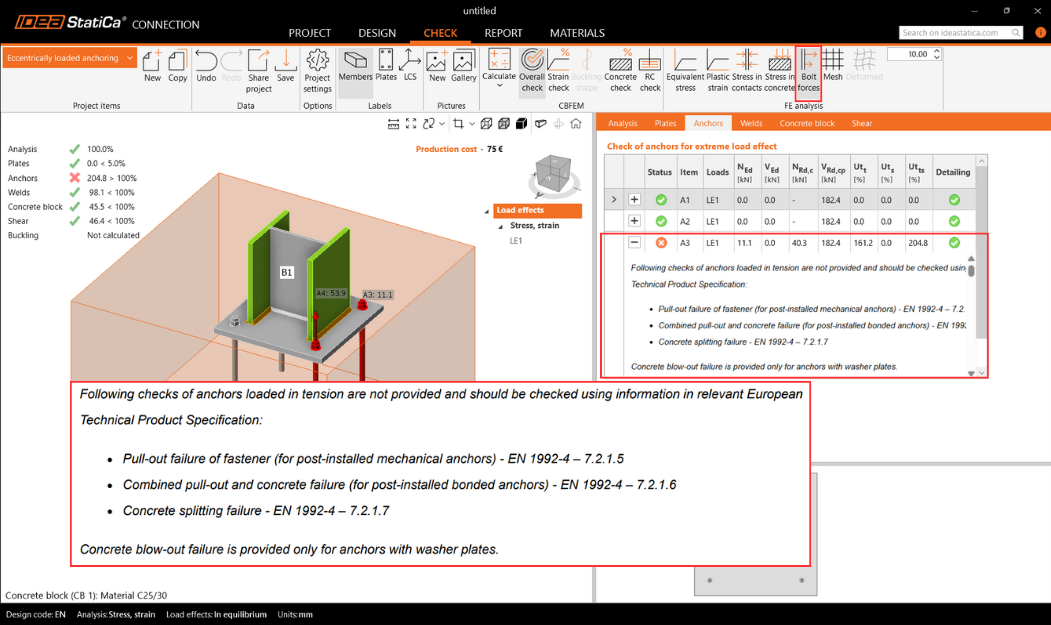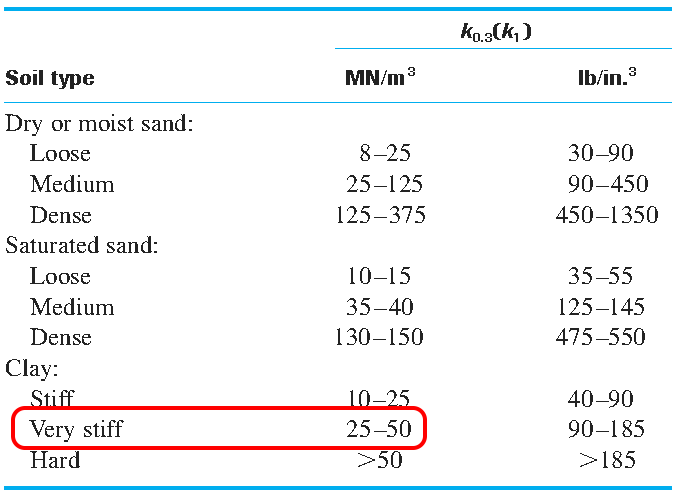BIM-link Connection naar Detail - Excentrisch belaste verankering
1 Nieuw project
Start de IDEA StatiCa Connection applicatie.
Houd de standaardinstellingen voor verankering en open de app.
2 Ontwerp
Nadat we de template hebben geopend, moeten we de Bewerkingen exploderen om de voetplaat aan te kunnen passen.
Laten we de voetplaat aanpassen en de overdracht van de dwarskracht instellen als wrijving.
Opmerking: Sinds de release van versie 24.1 is IDEA StatiCa Detailuit BETA voor 3D-verankeringsontwerp. Met deze nieuwe versie kan afschuiving ook worden overgebracht via ankers, afschuifogen en wrijving.
Voer de interne krachten in voor biaxiaal belaste verankeringen. De interne krachten veroorzaken drukspanning op het contact tussen de plaat en het betonblok. Standaard wordt aangenomen dat het betonblok gescheurd is.
3 Controleren
Bereken en ga naar de Controle. De normtoetsing geeft aan dat de ankers niet voldoen. Laten we hier dieper op ingaan.
Hieronder worden de bezwijkmechanismen voor ankers weergegeven voor trek en afschuiving volgens EN 1992-4.
Bekijk de gedetailleerde controle van de ankers, want op de eerste pagina staat een afwijking. Hierin staat welke codecontroles je handmatig of met andere methoden moet uitvoeren, omdat ze niet in IDEA StatiCa Connection zitten. Het is aan te raden om de nodige stappen te nemen om dit op te lossen.
De Anker toetsing voldoet niet:
- Het probleem wordt veroorzaakt door de betonnen uitbreekweerstand van ankers in trek en afschuiving.
- Dit probleem kan eenvoudig worden opgelost in IDEA StatiCa Detail met de 3D CSFM-methode. Het helpt je om het model van gescheurde betonblokken in IDEA StatiCa Connection te overwinnen.
4 Exporteren
De in-house ontwikkelde toepassing IDEA StatiCa Connection beschikt nu over een krachtige BIM-koppeling naar Detail, waarmee gewapend betonblokken met meerdere combinaties kunnen worden ontworpen en gecontroleerd.
Voorwaarden voor export:
- Het model moet vooraf zijn berekend en de resultaten moeten zijn opgenomen
Ga naar de kaart Controleren -> RC-controle -> Opslaan.
Exporteren is alleen toegestaan voor verankeringstopologie. De export staat de overdracht toe van:
- Het betonblok
- Ankers
- De voetplaat
- Belastingen
Aanvullende informatie en parameters die worden ingesteld volgens de overeenkomstige instellingen in de Connection:
- Afschuifkracht overdracht (via Ankers, kluft en Wrijving)
- Materiaal
- Type verankering: chemisch/ingestort
- Type verankering aan het uiteinde: Recht
- Wrijvingscoëfficiënt
5 Ontwerp
In dit onderdeel kun je Staven, Ondersteuningen, Belastingen en Wapeningsstaven aanpassen.
Ondersteuning
De ondergrond heeft enige stijfheid, waarmee rekening moet worden gehouden voor een nauwkeurig ontwerp. De Surface Support maakt stijfheid in alle drie de richtingen mogelijk en is standaard inactief voor trek (Compression-only).
- Wees voorzichtig bij het maken van aannames over randvoorwaarden. In het geval van niet-lineariteit, als de momenten vrij hoog zijn, kan het betonblok in trek tijdens de analyse omkantelen, wat grote rotaties veroorzaakt. Dit kan leiden tot een afwijkend model en onbetrouwbare resultaten.
Overdracht van krachten
De ankers zijn overgenomen uit IDEA StatiCa Connection. Er kunnen twee soorten ankers worden geselecteerd.
Ingestorte ankers:
- Vooraf geïnstalleerde ankers met dezelfde eigenschappen in Connection als de wapeningsstaven.
Chemische ankers:
- Achteraf-geïnstalleerde lijmankers met de optie om de aanhechtsterkte aan te passen, afhankelijk van het type anker.
Let op de juiste instelling van de Verbinding met een voetplaat. In het geval van het importeren van de voetplaat vanuit de Connection, moet de Overdracht van axiale krachten UIT staan en de Overdracht van afschuiving AAN. De reden hiervoor is dat de ankers direct door krachten worden belast. Je kunt hier meer hierover lezen.
Als je een nieuwe fundering zou ontwerpen in de detailtoepassing, zouden beide opties AAN staan. Bij het overbrengen van afschuiving via ankers moet de gebruiker bepalen welke ankers de afschuifkracht zullen dragen en het bijbehorende selectievakje inschakelen. Dit komt overeen met de EN-vereisten, die specificeren dat afschuiving alleen moet worden toegewezen aan ankers die effectief zijn voor de controle op het falen van de betonnen rand.
Wapening
Stel de betondekking in op 40 mm, die als standaardwaarde voor de wapening zal worden gebruikt.
Selecteer de Wapening (1)-->Groep van staven 3D(2) en vul de Diameter, Eigenschappen en Geometrie (3) in.
Kopieer de bewerking en wijzig het Oppervlak. Alle andere opties blijven behouden.
Kopieer de bewerking en wijzig de onderstaande opties.
Kopieer de bewerking en wijzig de onderstaande opties.
Belasting en combinaties
Combinaties worden overgenomen uit IDEA StatiCa Connection. Alle gevolgen van het importeren worden in detail besproken in - Importeren van verankeringen van Verbinding naar Detail.
Laten we het eigen gewicht creëren:
Maak een combinatie met eigen gewicht en voeg de coëfficiënt voor eigen gewicht = 1,35 toe volgens de codes
EN 1991-1-1
6 Controleren
Voordat je de berekening uitvoert, raden we je aan om de mesh-vermenigvuldiger op 2 of 3 te zetten om de berekening te versnellen. Deze stap is niet verplicht, maar kan de rekentijd verkorten en eventuele divergentieproblemen helpen opsporen. Als alles goed werkt en er zich geen problemen voordoen, kunt u terugschakelen naar een vermenigvuldigingsfactor van één.
Resultaten
Equivalente hoofdspanning
De equivalente spanning (EPS) in beton wordt bepaald op basis van het volumegedrag van het betonblok. De gebieden met de hoogste belasting worden geïdentificeerd en gemarkeerd. Meer informatie over equivalente hoofdspanning is opgenomen in dit artikel over de theoretische achtergrond.
Spanning in wapening
Tijdens de wapeningscontrole is het belangrijk om op te merken dat het anker dicht bij de hoek maximaal wordt gebruikt.
Bij het weergeven van het gebruik van wapening, kan de gebruiker duidelijk zien welke wapening bijdraagt aan het overbrengen van de belasting en het voorkomen van het falen van de betonnen uitbreekkegel.
Verankering
Controleer de Ankerinstellingen en activeer de Totale kracht in ankers. De krachten in de ankers kunnen licht variëren door de verschillende berekeningsmethoden met betrekking tot het betonblok. De verschillen zijn echter niet significant.
Vervormingen
Ga naar Hulp en zet Deformatie aan.
Het is niet nodig om een vervormingscontrole uit te voeren voor UGT, maar het wordt sterk aanbevolen om de vervorming na de analyse te controleren om er zeker van te zijn dat het model geen grote vervorming of grote rotatie ondervindt of dat een eindig element beschadigd is. Dit geeft een overzicht van de analyseresultaten en helpt bij het identificeren van eventuele problemen die tijdens de analyse zijn ontstaan.
7 Rapport
Ga ten slotte naar Rapport. IDEA StatiCa biedt een volledig aanpasbaar rapport om af te drukken of op te slaan in een bewerkbaar formaat.
Je hebt het hele ontwerp van de verbinding gecontroleerd volgens de normen EN 1993-1-8 en EN 1992-4. Het stalen deel is gecontroleerd in IDEA StatiCa Connection en het betonblok en wapening is gecontroleerd in IDEA StatiCa Detail.




